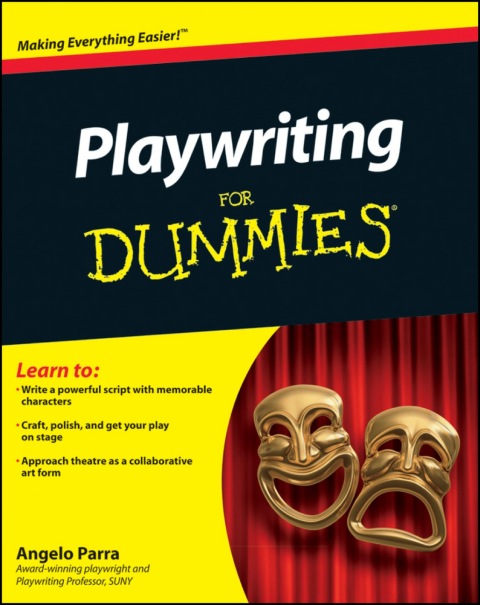Description
Efnisyfirlit
- About the Author
- Dedication
- Author’s Acknowledgments
- Table of Contents
- Introduction
- About This Book
- Conventions Used in This Book
- What You’re Not to Read
- Foolish Assumptions
- How This Book Is Organized
- Icons Used in This Book
- Where to Go from Here
- Part I: Catching the Playwriting Bug
- Chapter 1: Introducing the Art and Craft of Playwriting
- Understanding the Nature of the Beast
- Glimpsing the Life of a Playwright
- It Ain’t Over ’Til It’s On Its Feet
- Chapter 2: Living the Life of a Playwright
- Discovering What Makes a Playwright
- Learning from Other Playwrights
- Working Like a Playwright
- Exploring the Tools of the Trade
- Making Money the Playwright Way
- Using Playwriting Skills Outside of Theatre
- Chapter 3: What Makes a Play
- Shining a Light on the Magic and Simplicity of a Play
- Understanding Playwriting Lingo
- Following the Formula for Engaging and Compelling Plays
- Looking at How Scenes Work
- Discovering that It Takes a Village to Bring a Play to Life
- Chapter 4: Starting with an Idea
- Where Winning Story Ideas Come From: Observing Life
- Giving Up the Fear of Self-Revelation
- Avoiding Stories from the Wrong Sources
- Never Trust Your Memory: Preserving Your Ideas
- Chapter 5: Finding Your Play’s Theme
- Deciding on a Theme
- Conveying Your Theme without Losing Your Audience
- Surveying Themes in Three Classic Plays
- Part II: Creating a Blueprint for Your Play
- Chapter 6: Putting Your Story in Focus
- Asking Yourself the Five Ws (and an H)
- Keeping the Stakes High
- Choosing between Comedy and Drama
- Picking the Right Form for Your Story
- Chapter 7: Creating Full and Rich Characters
- Creating Lifelike People
- Weighing Storytelling versus the Privacy of Friends and Family
- Setting Up Your Characters to Drive the Play
- Chapter 8: Dialogue: The Most Important Tool in Your Toolbox
- Writing Purposeful Dialogue
- Using Dialogue to Its Full Potential
- Making It Sound Real
- Following Key Do’s and Don’ts of Dialogue
- Writing Monologues, Soliloquies, and Asides
- Chapter 9: Practical Considerations: Staging, Cast, and Audience
- Writing Plays with Staging in Mind
- Recognizing the Human Factor
- Part III: The Nuts and Bolts of Putting Your Story Together
- Chapter 10: The Beginning: Finding a Starting Point for Your Play
- Laying the Foundation Before Pen Hits Paper
- Deciding Where to Start Your Play: The Point of Attack
- Firing the Starting Gun: The Inciting Incident
- Bringing the Audience Up to Speed: Exposition
- Looking at Beginnings in Classic Plays
- Chapter 11: The Middle: Developing Your Story Line
- Finding Meaning in the Middle
- Conflicts Make the Play Go ’Round
- Using Suspense, Setbacks, and Other Storytelling Tools
- Varying the Mood
- Making the End of Act I a Nail-Biter
- Surveying Middles in Three Plays
- Chapter 12: The Climax: Bringing the Conflict to a Head
- Acknowledging Where Your Story Stands
- Crafting the Play’s Climax
- Finding the Ending to Your Story
- Avoiding the Problematic Deus ex Machina Ending
- Satisfying the Audience
- Surveying Climaxes in Three Plays
- Chapter 13: The Resolution: Wrapping It All Up
- Picking Up the Pieces
- Resolving Three Classic Plays
- Chapter 14: Giving the Musical Special Consideration
- Taking a Look at the Medium of Musicals
- Writing the Libretto
- Partnering in the Creative Team
- Part IV: The Show Must Go On
- Chapter 15: Getting Your Play Read and Making Revisions
- Readying Your Play for the World
- Getting Feedback on the Early Draft
- Tackling the Grisly Task of Rewriting
- Going Another Round with Your Advanced Draft
- Chapter 16: Rehearsals and Premieres: Nail Biting 101
- Getting Acquainted: Who’s Who in Your Production
- Conducting Auditions
- Attending Rehearsals
- Seeing Your Play Performed — Finally
- Surviving Opening Night
- Chapter 17: Promoting Your Play and Getting a Production
- Considering the Producer’s Perspective
- Taking the First Steps toward a Production
- Championing Your Play (And Getting Others to Join You)
- Keeping Pace with the Theatre World
- Part V: The Part of Tens
- Chapter 18: Ten Things Every Playwright Should Know
- Why People Do the Things They Do
- Plays Should Show, Not Tell
- Writing Is Rewriting
- Plays Aren’t for Preaching
- Characters Shouldn’t Be Interchangeable
- Problems Won’t Be Solved in Production
- Money Talks
- You Have Strengths and Weaknesses
- Patience Is a Virtue
- When to Take a Vacation
- Chapter 19: Ten Hallmarks of a Great Play
- Characters the Audience Can Care About
- A Story Line that Keeps ’Em Guessing
- A Timely and Relevant Subject
- A Time and Place that Transport Audiences
- Dialogue Expressing Inspiring Sentiments
- Honesty and Openness
- Specificity that Can Be Universal
- Simplicity and Clarity in Storytelling
- A Surprising, Yet Inevitable, Ending
- Themes Illustrating the Human Condition
- Chapter 20: Ten Playwrights You Should Know and Emulate
- Sophocles
- William Shakespeare
- Anton Chekhov
- Lillian Hellman
- Tennessee Williams
- Arthur Miller
- Samuel Beckett
- Edward Albee
- August Wilson
- Neil Simon
- Appendix: Formatting a Script
- Index






Reviews
There are no reviews yet.